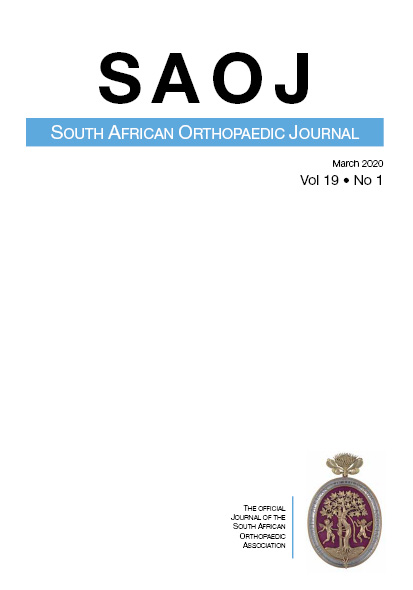Femoral lengthening in children
Keywords:
femoral lengthening, distraction osteogenesis, leg length discrepancy, congenital short femurAbstract
Background: We evaluated the outcomes following femoral lengthening by distraction osteogenesis in children. Additionally, we determined the incidence and nature of complications, the management thereof and factors associated with the development of complications.
Method: A retrospective review was performed of all patients who underwent femoral lengthening as an isolated procedure at our institution. Data regarding presenting details and clinical course were collected and X rays analysed. The healing index (HI) and the percentage lengthened were calculated. Complications were defined as deep sepsis, joint contracture, fracture and neurological injury.
Results: Fifteen patients underwent 16 femoral lengthenings from 2008–2018. Nine patients had congenital short femur or proximal focal femoral deficiency, three patients had sequelae of meningococcaemia and four had various other pathologies. The median age at time of surgery was 9 years (6–13). Median follow-up was 1.6 years (0.5–6.6). The median HI was 32 days/cm (20–60). Leg lengths were equalised to ≤2.5 cm in 11 patients; length achieved was as planned in all but three patients. Eight patients sustained fractures on average six days (2–57) after frame removal, five through the regenerate. Four required surgery. Thirteen patients developed joint contractures of which six required additional procedures to address this. Two deep infections required surgery. Two patients developed neurological symptoms of which one recovered fully. Higher percentage length gained (>20%) was associated with increased fracture and joint contracture rate. Diaphyseal osteotomy, as opposed to metaphyseal, was associated with increased risk of fracture (71% vs 25%). A diagnosis of congenital short femur was associated with increased fracture rate. Spanning the knee did not prevent joint stiffness in 4/5 patients but did prevent subluxation.
Conclusion: Femoral lengthening using external fixation can be successful in achieving leg length equality, but complications are common and often require additional surgery. Limiting lengthening to less than 20% of the original bone length and performing the osteotomy through the metaphysis decreases the risk of fracture and joint contracture.
Level of evidence: Level 4
Downloads
Published
Versions
- 2021-08-11 (2)
- 2020-03-16 (1)

